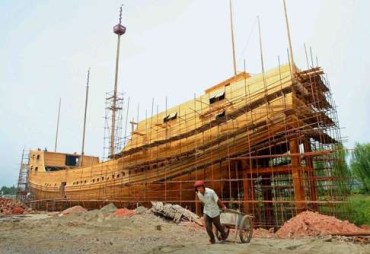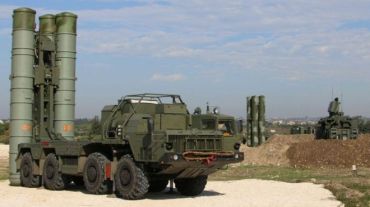Near my childhood home in Kunming (昆明), Yunnan (雲南) province, is a park dedicated to its most famous son: Admiral Zheng He. 
Our teacher would take us to pay tribute to the great eunuch of the Ming dynasty, recounting his legendary seven expeditions that brought glory to the motherland.
The marble bust of Zheng He shows the face of a typical Chinese, with a square chin, brushy eyebrows and a flat nose. My father joked it more resembled comrade Lei Feng than the admiral. Not until years later did I realise how true this was.

A statue of Zheng He in Nanjing, where his armada was built. File photo
The statue was erected in 1979 – a year after Deng Xiaoping (鄧小平) launched his open-door policy. Zheng, barely mentioned during the Cultural Revolution, was plucked from obscurity and hailed as a national hero who embodied China’s open spirit. A park near his ancestral home was dedicated to him. The same craftsmen who churned out revolutionary statues were employed to build his.
In real life, Zheng probably looked very different. My school textbook mentioned only that he was a Hui minority (Muslim Chinese). In fact, the admiral was a descendent of a powerful Persian family. Records discovered in 1913 trace his lineage to Sayyid Ajall, who was sent by Kublai Khan to conquer Yunnan and became its first governor. In 2014, Chinese scientists at Fudan University in Shanghai put the theory to test. They examined DNA samples collected from descendents of the admiral’s close kin and found they originated from Persia, modern-day Iran. In addition to Zheng He, most senior officers of the storied Ming armada were also Muslims.
Beijing follows the route well travelled by Admiral Zheng He in its belt and road initiative
Over the past decades, researchers have concluded Zhang and his armada were the key force behind Islam’s spread in Southeast Asia. The Arabs established settlements in Southeast Asia from the eighth century. But Islam did not become dominant there until the 15th century – around the time Admiral Zheng began to sail in the South China Sea. Historians found evidence of Zheng’s missionary work in documents discovered in Semarang, Indonesia, by Dutch officials in 1925. This prompted Indonesian religious leader Hamka to write in 1961: “The development of Islam in Indonesia and Malaysia is intimately related to a Chinese Muslim, Admiral Zheng He.
”A crowning moment of Zheng’s expedition was converting the King of Malacca, Parameswara, to Islam shortly after he paid homage to the Yongle Emperor in Beijing in 1411. The conversion played a crucial role in the spread of Islam in Southeast Asia, according to Professor Xiao Xian of Yunnan University.

A replica of a ship used by Ming Dynasty eunuch explorer Zheng He, in Nanjing. Photo: Reuters
Xiao was one of the scholars who presented research work on Zheng He at an international symposium in 2005. They painted a vivid picture of the Ming armada, which had all the elements of a multinational enterprise.
The 300 ships – many twice as big as the largest European vessels of the time – were constructed in dry docks in Nanjing ( 南京 ), Jiangsu ( 江蘇 ) province. Building materials were sourced from across the Ming Empire. The 27,000-strong crew included Han Chinese, Muslim Hui, Arabs, Persians, and peoples from Central and East Asia. The lingua franca was Persian or Sogdian – a language used for centuries by merchants of the ancient Silk Road, according to Professor Liu Yingsheng of Nanjing University.
Size was not the only difference between Zheng’s fleet and that of Christopher Columbus 70 years later. The Europeans aboard the Santa Maria were exclusively Catholic – the Ming fleet was culturally and religiously diverse. Zheng was a Muslim but he was fluent in the teachings of Confucius, Buddhism and classic Chinese philosophy. The fleet included many Buddhist missionaries. Many regard his expeditions as the high-water mark of Chinese civilization. The Ming armada’s true greatness lay not in its size or sophistication but in its diversity and tolerance.

A statue of famed Chinese navigator Zheng He overlooks the city of Nanjing, Jiangsu province. Photo: AFP
After the Yongle Emperor’s death, the Ming court lost its global vision. Power was in the hands of the Confucius gentry-class, who jealously guarded against other schools of thoughts. China became increasingly introspective and insulated. The court stopped further expeditions and banned seafaring. The Chinese civilization gradually lost its vigour and started a long decline.
Today as the new “Silk Road” and “soft power” become China’s new catchphrases, it is important to remember what makes the Chinese civilization unique in the first place. Its greatest strength lies in its people’s amazing ability to absorb, adopt and assimilate different cultures.
Buddhism, which originated in India, flourished in China. The Zen school – a hybrid of Indian Buddhism and Chinese Taoism – spread to East Asia by monks in the Tang dynasty and became mainstream. Islam arrived from Central Asia and the Middle East during the Yuan and Ming dynasties. It took root in western China before spreading to Southeast Asia with Zhang’s fleet. We should remember that until 100 years ago, China was not a nation state in the Westphalian sense. Narrow-minded nationalism and xenophobia are the exception rather than the norm of the world’s oldest surviving civilization.
Source: The Chinese admiral who spread Islam across Southeast Asia | South China Morning Post














